
27.02.2017
The Lithuanian performer talks with the Colombian artist about art in the U.S. after Trump, body knowledge and the vitality of the absurd in absurd times.
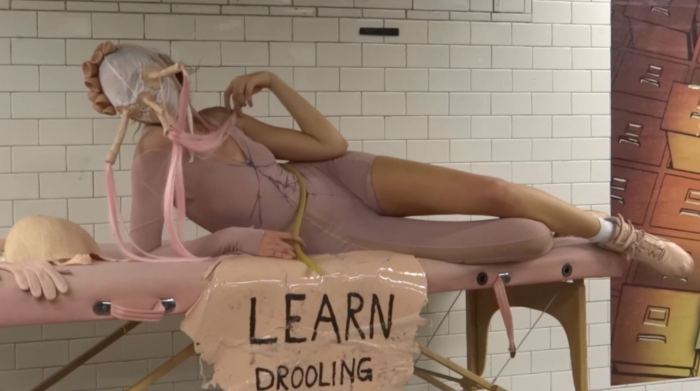
Ieva Misevičiūtė This is a great occasion —Jessica and I have had many delightful conversations that carried me through my practice over the past six years. It all began when I moved to New York and started working on my solo performances. My method then was to go to open mics and improvise, that way generating material. At some point, I found myself buried under all those bits. In such situations, as I’ve learned in academia, it’s the time to invite a supervisor into your life. I thought of a person who would be the most understanding of my Eastern European sensibility and that person was Jessica. I don’t know exactly why, but I think there is some sort of metaphysical understanding between people from Latin America and Eastern Europe, something about humor, the absurd, a similar darkness with a twist, a sparkle.
I would visit Jessica at her studio with things like buckets, a fur covered music stand, or a rubber tote bag filled with boiling water and edible sponges, and I’d perform for her, testing and refining my first solo. Ever since then, to a degree, I developed all my work in that space —all these props, dance moves and stage images, were growing out of Jessica’s studio like a twin brain.
PART 1
Jessica Mitrani: Sparkles! In December, prompted by the US election, we decided to go together to the panel titled “Film and media in a time of repression: Practices and aesthetics of resistance,” at the Film Society of Lincoln Center in New York. The idea around the event was to examine what “resistance looks like today.” On our way uptown, we talked about Ieva growing up in Lithuania in the 80s. Can you tell me again about your communist kindergarten?
IM: Sure! In my kindergarten in Kaunas whenever kids would misbehave the teachers would threaten that they would take off our panties and put us up on in front of the window so that the older children coming back from school would see us and laugh. One day during naptime, we realized that all the teachers were gone from the building and impulsively we all started crawling out of our beds, taking off our panties and taking turns standing up at the window.
JM: Amazing. A fairy tale of subversion. The collective act of the kids turned the “shame and punishment” inside-out and rendered them obsolete. It would probably not happen if you were teenagers since the relationship with the body is so delicate during that time, but for very young kids it’s almost natural to want to leave their pants off!
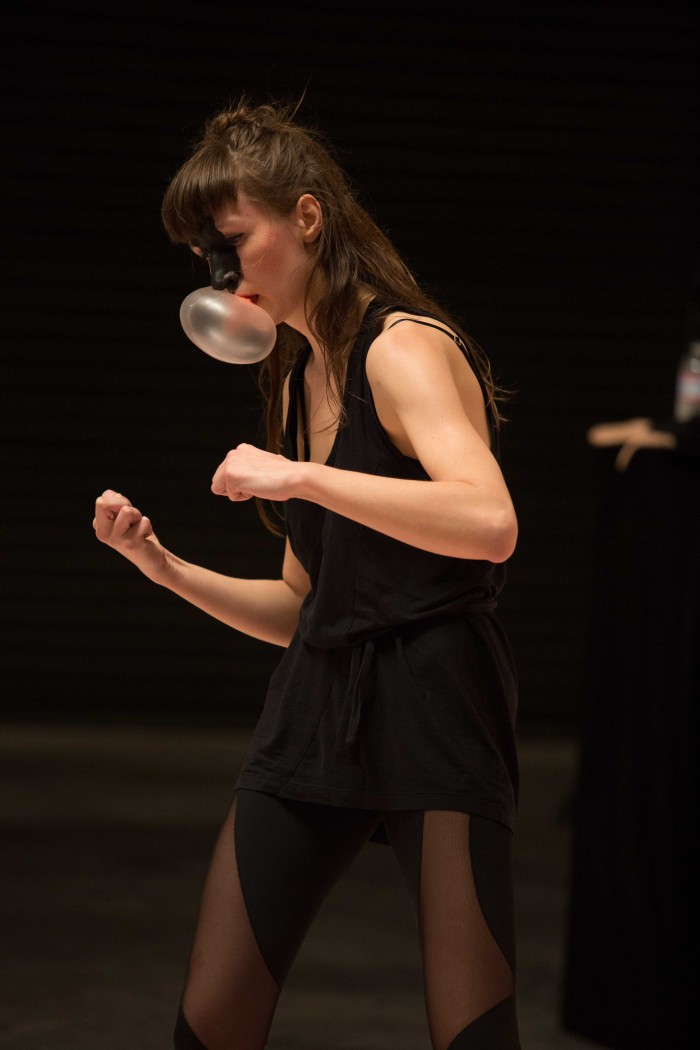
PART 2
JM: I get annoyed when people started saying, after the election this year “Oh, art is going to be amazing now, great art is produced during the toughest circumstances,” as if the past 3,000 years have been a walk in the park. But still, let’s talk about art after Trump.
IM: I think that there is a certain unbreakable strength in metaphors, and in times of greater political oppression there will be more art that speaks in very vivid metaphors. We are not there yet, we are not living under a totalitarian regime right now. It is something we anticipate and have living memories of, but what this is that we’re facing we do not yet know.
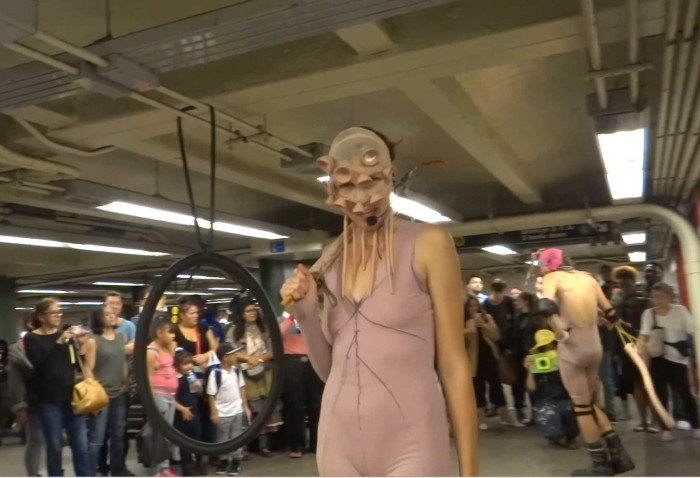
JM: I remember you passing by my studio in October, right before going to perform on the Union Square subway platform, and we had a short discussion about how to use language in the street.
IM: Ah, yes! I just did a performance in the New York subway where I had a sign that said, “Learn Drooling.” I was puzzled after that show, as I thought maybe people could not connect to it, that maybe it was too abstract. When I was passing by your studio, I was planning to do another performance, in a series that’s called “Nihilist News,” with the more explicit taglines, “No News Today” and “Our Political Climate seals ‘No Future’ verdicts to the human race.” In retrospect, I think both performances went very well, as they did not depend on words or verbal logic. In the streets, what matters is the situation you create, a sort of pressure cooker environment, an intense guttural washing machine. The language then is just like icing on the cake.
I read an interview with Adam Curtis about art after Trump, where Curtis says that art and journalism are essentially the same —they give people a perspective on reality. I, of course, agree. But here is one more element missing in his argument. Do you know that feeling when you walk out of a great theater play, or a music concert, or a performance, or just finished reading an amazing book and you want to live? Not just live, but LIVE in capital letters. For me that’s the main and the most important purpose for art and journalism. And such strong epiphanies do not alone come from sheer logic being used to inform people.
JM: I don’t know if I agree with the part that art is meant to inform people. I mean, it might be, but especially after the election, we saw that information, or at least that facts, meant very little (debates were not won because of facts). We, the so-called progressives, failed to understand that politics are emotional. We must be tribal-based in the use of images if we want to create change. In that sense, I think your street performance is politically effective. We are in a battle of the symbol. Can you talk about your use of the boom box in the streets of New York?
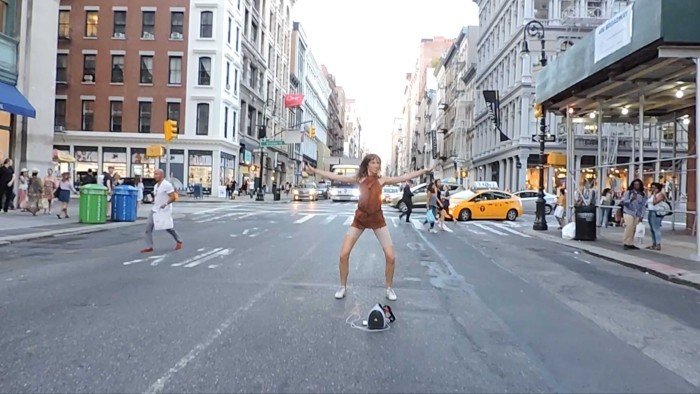
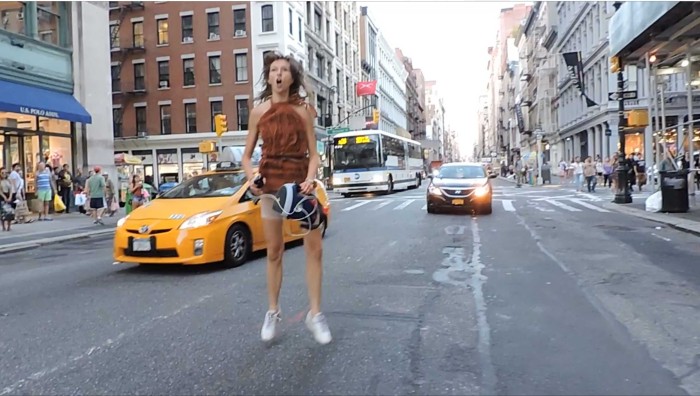
IM: The boombox is a gun that gets increasingly loaded when you travel from the outskirts of Brooklyn to Uptown Manhattan. It’s totally mathematic:
1. Bed Stuy: I dance with everyone that I encounter on the streets.
2. Canal street/downtown Manhattan: I dance alone, occasionally some people join, everyone is cheering, traffic stops, and the police have no problem with me.
3. Midtown: people are annoyed and close their ears, I get angry looks, and the only people who affirm my music are delivery guys.
4. Uptown: they call the police.
IM: But I want to get back to your earlier thought. Are you saying that it’s more important than ever to communicate using symbolic actions? Also, what do you mean by tribal? Does that have something to do with the power in ritualistic symbolism?

JM: I mean that we must appeal to the unconscious and that’s what Trump very effectively did. He got an emotional reaction from people, he appealed to the repressed. He created a bond between his supporters. It’s the same bond that you see in full stadiums at soccer matches. It’s an excited bond, based on a sense of belonging to something.
IM: Right! The strength of this lies in the ability to surrender individualism for the good of the group, something I was thinking about these days. In New York, I’ve found that the people that surround me are so good at taking care of themselves that I grew to see this as an expression of American liberal culture, which sometimes really annoys me too. For instance, when I lead a workshop and ask my students to commit to the group action and then someone needs to take a little break, “to take care of themselves,” dropping the whole energy we just built as a collective. And when political climate became much more intense here in the US, I started to think of communism as an antidote to fascism. But imagine a communism built of hyper-individualists! This actually could be really good! In the best-case scenario, this would be some form of neo-pagan communities, in which individuals might consciously agree and surrender to the group but retain their sanity.
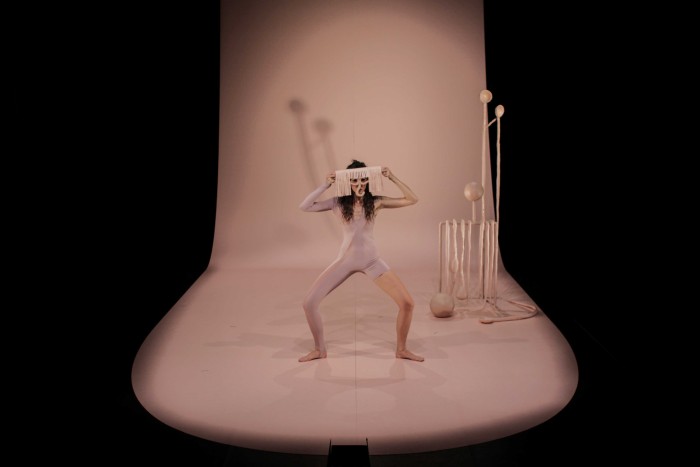
PART 3
JM: When I met you a couple of years ago you started this rigorous body training. I was thinking about the boundaries of discipline and suffering, or of discipline and morality attached to it.
IM: Yes, you are talking about my Butoh training. When I started it, I was doing stand up with a lot of physical theater elements. The study of Butoh turned my light-hearted comedy sketches into much deeper and darker material. I loved it at that time. I think it touched on my Eastern European existentialism and also connected with Baltic pagan traditions. However, at some point, I found myself locked into this system. I saw that my work started losing lightness, play, and humor, and I felt like my inner clown was dying. At that time, I was following the Tatsumi Hijikata lineage of training, which is also called Ankoku Butoh, or “The Dance of the Darkness.” One of the core ideas is that to activate extraordinary energy, one has to go through a certain amount of difficulty and pain; it’s like dipping yourself in a sauce of endurance that is transformative. In there you find the point of surrender, a place where there is no difference between suffering and surrender —a very wonderful place in fact! I have never given birth, but I believe it’s very much the same principle, like something very primal, something of a wild animal where there is no compromise, just action. It is rejuvenating and mobilizing, but if used too much, it begins to destroy you.
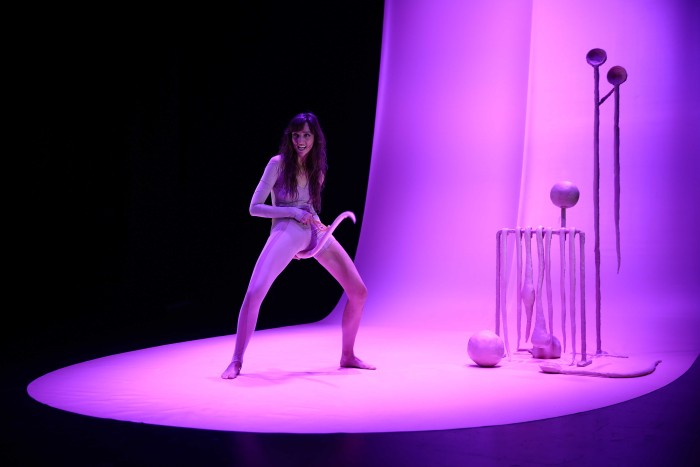
JM: There is definitively a tremendous value to chaining yourself voluntarily, meaning fully aware, to a system, an institution, a partner; chains are beneficial too. But tell me how you found other channels?
IM: Exactly, other channels!
JM: When do you know that it’s time to exit?
IM: For me it’s when I notice that I don’t have any more joy, or that I am in constant physical pain, and that I am committing more than 90% of my life energy to my work. I think a lot of professional dancers would laugh at me for this, saying, “Yeah, wanna see my beaten-up feet?” I do respect the rigor of dance training, however, I think it is an outdated paradigm. I don’t want to bring a broken up, overworked and overextended body on stage and cultivate this as a cultural norm. I want to see a healthy, regenerating, and light body, moving gracefully no matter what age. Thus, I did two things, first, I started training like an athlete, and second, I looked for dance forms that are made by females and for the female body, and where the dancers perform until an old age. Mostly these are very ancient dance forms like belly dance.
JM: So, the feminine as a form of balance . . . I am going to the women’s march in January, I will carry a sign that reads: MISOGYNY IS NOT AN OPINION.
IM: Perfect! I’ll be there too! You know, when I get angry I go dancing in the streets. Angry about injustice, about sexism, angry about fear that keeps people from dancing, angry when I see powerful women being stepped on and all such moronity of everyday life. Then I go to Broadway in Soho, I dress up as girly as I can, I turn my boombox on very loud —the traffic stops, shoppers stop, and we all rewire our guts with new electricity.
JM: Sounds better than sex…
IM: Ideally, sex should follow right after [laughs]. I think the more creative work you do, the more sex you should have.
JM: Which is the opposite of what Freud said, that instead of having sex you sublimate and create art.
IM: Ok look, this is my new theory: creative work raises a lot of yin energy in the body and the nature of that energy is expansion / transparency, meanwhile sex grounds you. Too much yin energy can drive one into madness or existential numbness. Sex is like a flu shot for the disembodied.
JM: Do you feel more sexual when you are creating a new piece or performing?
IM After a performance, I would want to make love immediately, because you are in such a high. I read that Freddy Mercury would never go to bed alone after a show. I can totally understand why.

PART 4
JM: Can you tell me more about the idea of new academia in your recent production, Tongue PhD?
IM: The idea is that our bodies are infinite archives of information and that in addition to horizontal research, which is collecting facts, an equal value should be placed on vertical research, which is going into cellular intelligence, into the body, and the memories stored there.
JM: I am interested in the connection or the lack of connection between information and memory. This election represents the so called repressed of America, genocide, slavery, and misogyny. Even though if you look closely (Standing Rock, Black Lives Matter and so on) it wasn’t so repressed after all, but now the shadow is under the spot- light, courtesy of Trump.
IM: It’s a beast and we are just beginning to learn about it. But you are right, it was there, and now it is under the spotlight. I was in the middle of teaching my course at Malmö Art Academy when Trump was elected. Our work there is very physical and the theme of locating the pockets of oppression within our subconscious and in our bodies, came up a lot. For a short moment, in light of all of the events, I thought, gosh! We are doing such minor work, we need to do more. But then immediately it occurred to me that the work goes both ways —we find the pockets of oppression within the psyche AND we work externally. The internal work is like detecting the air bubbles that need to be destroyed in order to build each individual solid, a lot can be done from that place after locating the invisible. Through this work we arrive at a much more solid foundation of trust in our inner intelligence and that place can help us navigate this post-truth moment.
AND more wild imagination, please! What this election did is cause a tear in reality —Trump, his supporters, and this army of billionaires just imagined a reality that they want to live in. We should have a solid alternative and throw it into that tear with the same conviction.


Comments
There are no coments available.